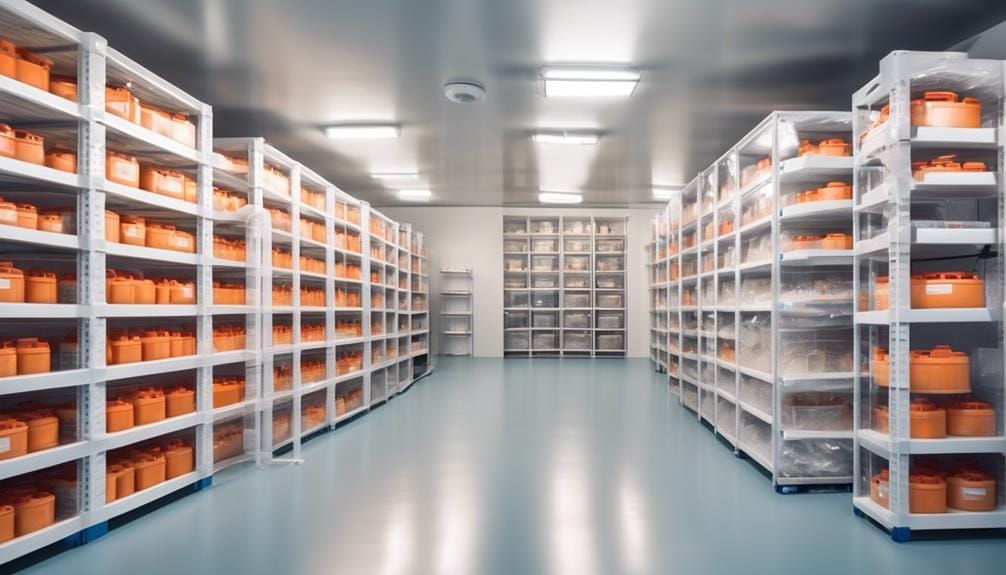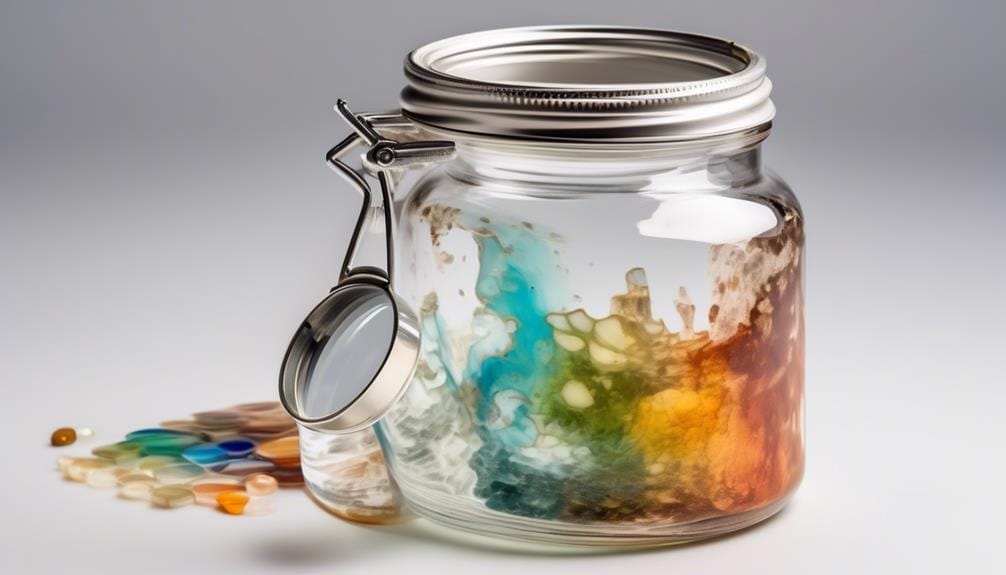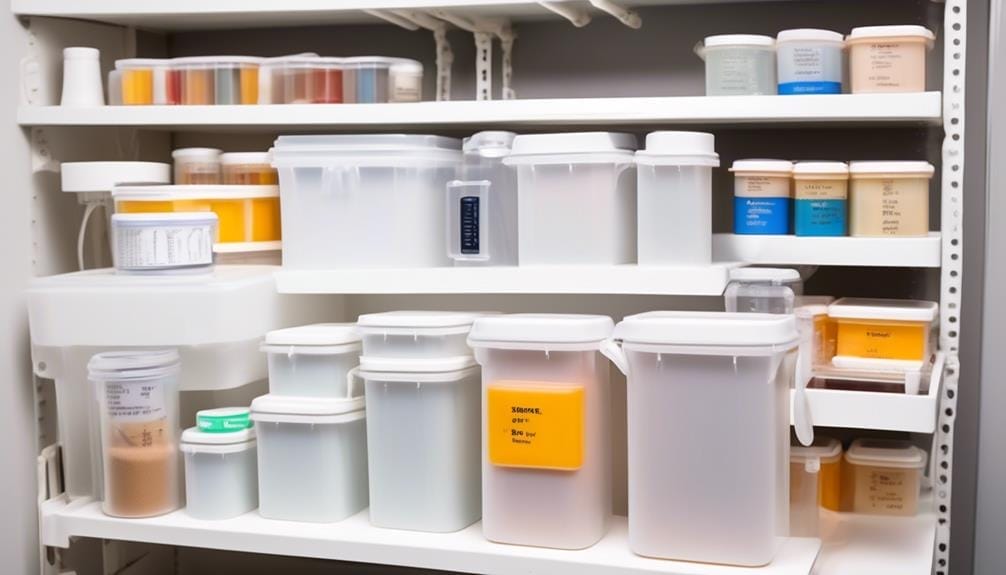Are you tired of wasting epoxy resin due to improper storage? Well, fear not because we have the solution for you.
Picture this: you’re in the middle of a project, and suddenly, you realize your epoxy resin has hardened before you even had a chance to use it. Frustrating.
But what if we told you there’s a way to extend the shelf life of your epoxy resin and ensure its usability for years to come? In this discussion, we will explore the art of epoxy resin storage and reveal the secrets to maintaining its effectiveness.
Get ready to unlock the key to successful epoxy resin preservation and say goodbye to wasted material.
Key Takeaways
- Proper storage techniques, such as storing epoxy resin in a cool, dry place away from direct sunlight, are crucial to maintain its quality and effectiveness.
- Epoxy resin generally has a shelf life of six months to a year, but this can vary depending on formulation, storage conditions, and stabilizers.
- Factors that can negatively impact the shelf life of epoxy resin include extreme temperatures, moisture, and exposure to light.
- Expired epoxy resin can lead to improper curing, decreased strength, changes in properties, reduced adhesion, and increased brittleness, compromising the quality and durability of finished projects.
What Is Epoxy Resin?
Epoxy resin is a thermosetting polymer that, when combined with a hardener, undergoes a chemical reaction to create a strong, rigid material with excellent adhesive properties and resistance to heat, chemicals, and moisture. This durable and versatile synthetic material has a wide range of applications in crafts, construction, and marine projects.
One key aspect to consider when working with epoxy resin is its shelf life. The shelf life of epoxy resin can vary depending on factors such as formulation, storage conditions, and the presence of stabilizers. It’s crucial to store epoxy resin properly to maintain its quality and effectiveness.
Generally, epoxy resin has a relatively long shelf life, ranging from six months to a year. However, it’s essential to check the manufacturer’s recommendations for specific storage instructions and expiration dates. Exposure to extreme temperatures, moisture, and direct sunlight can negatively impact the shelf life of epoxy resin. It’s best to store it in a cool, dry place, away from direct light and heat sources.
When working with epoxy resin, it’s advisable to use fresh materials for optimal results. Expired or degraded epoxy resin may not cure properly, leading to weak bonds or insufficient coating. Therefore, regularly checking and properly storing epoxy resin is essential to ensure its usability and effectiveness.
How Long Can Epoxy Resin Be Stored?
Proper storage techniques are crucial to ensure the longevity of epoxy resin. Epoxy resin can last many years when stored properly at room temperature and in closed containers. Unlike polyester resins, which have a shelf life of about six months, epoxy resins, such as WEST SYSTEM Epoxies, offer an excellent shelf life.
However, it’s important to perform pot life tests to determine the usability of questionable resin and hardener. Solvent-free epoxies have unlimited shelf lives when stored in sealed containers. It’s recommended to test older resin and hardeners before large installations.
Shelf life can be affected by opened containers and improper resealing. Proper storage helps maintain the lifespan of epoxy resin by preventing premature curing or hardening. Good housekeeping practices, such as keeping containers tightly closed and free from moisture, can contribute to the longevity of epoxy resin. Additionally, storing epoxy resin in a cool, dry place away from direct sunlight can help preserve its quality.
Does Epoxy Resin Have a Shelf Life?

When properly stored in closed containers at room temperature, epoxy resin can have a shelf life of many years. Unlike polyester resins, which typically have a shelf life of only about six months, epoxy resins, such as those offered by WEST SYSTEM, offer an excellent shelf life. Even after several years, the resin and hardener can still cure fine, making them reliable options for various projects.
Proper storage and good housekeeping are essential to ensure the longevity of epoxy resin. When not in use, it is important to seal the containers tightly to prevent moisture and air from entering. Temperature fluctuations should also be avoided, as extreme heat or cold can impact the quality of the resin. Additionally, it is recommended to store epoxy resin away from direct sunlight, as UV exposure can degrade its properties.
To further illustrate the shelf lives of different types of resins, refer to the table below:
| Type of Resin | Shelf Life |
|---|---|
| Epoxy Resin | Many years |
| Polyester Resin | Approximately six months |
| Solvent-Free Epoxy | Unlimited, when stored properly |
Factors That Affect the Shelf Life of Epoxy Resin
Proper storage conditions play a crucial role in maintaining the shelf life of epoxy resin. Several factors can affect the shelf life of epoxy resin, and it’s important to be aware of these to ensure the longevity and effectiveness of the product.
Here are four key factors that can impact the shelf life of epoxy resin:
- Temperature: Epoxy resin should be stored in a cool, dry place. Extreme temperatures can accelerate the chemical reactions within the resin, leading to premature curing or degradation. It’s recommended to store epoxy resin at a temperature between 60°F and 80°F (15°C and 27°C) to maintain its stability.
- Exposure to light: Ultraviolet (UV) light can cause epoxy resin to turn yellow or become discolored over time. To prevent this, it’s essential to store epoxy resin in opaque containers or a dark area away from direct sunlight.
- Moisture: Epoxy resin is sensitive to moisture, which can lead to the formation of bubbles or a weakened bond. It’s important to keep the resin tightly sealed in its original packaging or an airtight container to prevent moisture absorption.
- Contamination: Contaminants such as dust, dirt, or foreign particles can affect the quality and performance of the epoxy resin. Ensure that the containers and tools used for handling the resin are clean and free from any contaminants.
Proper Storage Conditions for Epoxy Resin

To ensure the proper storage of epoxy resin, it’s important to consider temperature and humidity conditions.
Epoxy resin should be stored at room temperature to maintain its quality and extend its shelf life.
Additionally, it’s crucial to store epoxy resin in closed containers to prevent moisture contamination, which can lead to wastage and affect its performance.
Temperature and Humidity
Storing epoxy resin in a controlled environment with a temperature range of 60°F to 80°F and sealed containers is crucial for preserving its shelf life and quality. Here are four important points to consider regarding temperature and humidity when storing epoxy resin:
- Temperature control: Maintaining a consistent temperature within the recommended range helps prevent premature curing, which can reduce the shelf life of epoxy resin.
- Humidity levels: High humidity can lead to moisture absorption, causing the resin to become cloudy or develop bubbles. It’s essential to store epoxy resin in a dry environment to avoid these issues.
- Avoid extreme temperatures: Exposure to extreme heat or cold can degrade the quality and performance of epoxy resin. It’s best to store it in a stable temperature environment.
- Sealed containers: Using airtight containers prevents moisture and contaminants from entering and affecting the resin’s shelf life and integrity.
Container Type
Maintaining the recommended temperature range and using sealed containers are crucial factors to consider when storing epoxy resin to ensure its longevity and quality.
The choice of resin container is essential to preserve the resin’s shelf life. It’s recommended to use containers specifically designed for storing epoxy resin, such as plastic or glass bottles with airtight lids. These containers help to prevent moisture contamination, cross-contamination, and exposure to contaminants like dirt or chemicals, which can degrade the resin over time.
Additionally, using containers with proper sealing mechanisms, such as screw-on caps or snap-on lids, ensures a tight seal and minimizes the risk of resin leakage or evaporation.
What Happens When Epoxy Resin Expires?
When epoxy resin expires, several things can happen that affect its performance. The resin hardening process may be compromised, resulting in improper curing and decreased strength.
Additionally, chemical breakdown over time can lead to changes in the resin’s properties, such as reduced adhesion or increased brittleness.
These issues can have a significant impact on the quality and durability of finished projects, making it essential to use epoxy resin within its shelf life for optimal results.
Resin Hardening Process
Expired epoxy resin can lead to improper curing and diminished performance. Understanding the resin hardening process is crucial in determining the effects of expired epoxy resin. Here are four key points to consider:
- Material changes: Over time, resin and hardener can undergo changes such as crystallization, darkening, or thickening. Despite these changes, the material can still be usable with thorough mixing.
- Pot life tests: Conducting pot life tests can help evaluate the usability of expired resin and hardeners. It’s important to note that temperature significantly affects the pot life.
- WEST SYSTEM epoxy: WEST SYSTEM epoxy resin and hardener have been known to cure fine even after several years. However, it’s recommended to test older material before large installations to ensure proper performance.
- Small-scale testing: It’s advisable to test a small amount of expired resin before using it for large installations. This testing helps determine if the resin will cure properly and meet the desired performance standards.
Understanding the resin hardening process is essential when dealing with expired epoxy resin, as it can impact the overall performance and quality of the cured product.
Chemical Breakdown Over Time
As epoxy resin ages, it undergoes chemical breakdown that can affect its usability and performance. Over time, the resin may experience material changes like crystallization or darkening.
Despite these changes, the resin can still be used by thoroughly mixing it.
To determine the usability of questionable resin and hardener, pot life tests can be performed, with temperature significantly impacting pot life.
Proper storage is crucial in maintaining epoxy resin’s shelf life, ensuring it remains available for projects and performs as intended. Contaminants such as moisture, dirt, or chemicals can damage the resin or hardener, emphasizing the need to avoid contamination to prevent wastage.
Solvent-free epoxies have unlimited shelf lives when stored in sealed containers, but it’s advisable to test older materials for usability.
Impact on Finished Projects
Using epoxy resin beyond its expiration date can result in suboptimal curing and diminished performance, potentially compromising the quality of your finished projects. When epoxy resin expires, it may not cure properly or provide optimal performance, leading to potential issues. The expired resin may fail to harden completely or may not adhere properly, resulting in weak or brittle finished projects.
Additionally, the expired resin may have a shorter pot life, reducing the time available for working with the material. To ensure desired results and avoid wastage, it’s important to avoid using expired epoxy resin. Proper storage techniques, such as keeping the resin in a cool and dry place, can help extend the shelf life of the resin and maintain its performance.
Can Expired Epoxy Resin Still Be Used?
You can still use epoxy resin even if it has expired as long as you perform pot life tests to confirm its usability. While it’s generally recommended to use epoxy resin within its shelf life for optimal performance, expired epoxy resin can still be utilized under certain circumstances. Expired epoxy resin may not cure as effectively as fresh resin, but it can still be used for less critical applications or projects where appearance isn’t a primary concern.
Performing pot life tests is crucial in determining the viability of expired epoxy resin. Pot life refers to the amount of time epoxy resin remains workable after it has been mixed with its hardener. By conducting pot life tests, you can assess whether the expired resin still exhibits the desired characteristics and can be effectively cured.
Proper storage plays a crucial role in extending the shelf life of epoxy resin. Storing resin in a cool, dry place, away from direct sunlight and extreme temperatures, helps maintain its usability for a longer period. Additionally, keeping the containers tightly sealed can prevent moisture and air from affecting the resin’s performance.
It is important to note that the shelf life of epoxy resin can vary depending on the brand and type. While some epoxy resins, such as the UltraClear Table Top Epoxy, have a shelf life of one year for unopened containers, others, like WEST SYSTEM epoxy resin and hardener, can still cure fine even after several years.
How to Determine If Epoxy Resin Is Still Good to Use

To determine the usability of epoxy resin, perform a pot life test to assess its workability and curing effectiveness. Follow these steps to determine if your epoxy resin is still good to use:
- Prepare a small amount of epoxy resin according to the manufacturer’s instructions, mixing the resin and hardener in the correct ratio.
- Apply the mixed epoxy resin to a test surface and observe its behavior. Pay attention to factors such as viscosity, color, and consistency.
- Monitor the pot life, which is the amount of time the epoxy resin remains workable after mixing. If the epoxy resin becomes too thick or starts to harden before the pot life is up, it may no longer be usable.
- Allow the test sample to cure fully according to the manufacturer’s recommended curing time and conditions. Check for proper curing, such as a hard, durable finish.
Common Mistakes to Avoid When Storing Epoxy Resin
When storing epoxy resin, it is important to avoid common mistakes in order to maintain its quality and effectiveness. Proper storage is crucial to ensure that the epoxy resin remains usable for its intended purpose. Here are some common mistakes to avoid when storing epoxy resin:
| Common Mistakes | Proper Storage |
|---|---|
| Exposure to heat | Store epoxy resin in a cool, dry place away from direct sunlight. |
| Inadequate sealing | Ensure that the containers are tightly sealed to prevent moisture from entering. |
| Incorrect temperature | Maintain the storage temperature within the recommended range to prevent degradation. |
| Contamination | Store epoxy resin away from other chemicals to avoid cross-contamination. |
| Improper labeling | Clearly label the containers with the epoxy resin type and date of purchase. |
Tips for Extending the Shelf Life of Epoxy Resin

Proper storage and handling techniques can greatly contribute to extending the shelf life of epoxy resin, ensuring its usability for a longer period. Here are some tips to help you maximize the shelf life of your epoxy resin:
- Store in a cool, dry place: Epoxy resin should be stored in a temperature-controlled environment, away from direct sunlight and excessive heat. High temperatures can accelerate the curing process and reduce the shelf life of the resin. Similarly, humidity can lead to moisture contamination, affecting the quality of the resin.
- Keep containers tightly sealed: Exposure to air can cause epoxy resin to oxidize and harden, reducing its shelf life. Make sure to tightly seal containers after use to prevent air from entering. If the original container is damaged or no longer available, transfer the resin to a new airtight container.
- Avoid cross-contamination: Cross-contamination with other chemicals or substances can compromise the integrity of epoxy resin. Store resin away from solvents, oils, and other reactive materials to prevent contamination. Separate storage areas for different types of chemicals can help minimize the risk of cross-contamination.
- Practice good housekeeping: Maintaining a clean and organized workspace is essential for extending the shelf life of epoxy resin. Regularly clean containers, tools, and surfaces to prevent the accumulation of dirt, dust, and other contaminants. Implementing good housekeeping practices will help preserve the quality of the resin and ensure it remains usable for longer periods.
How to Prevent Yellowing of Epoxy Resin During Storage
To prevent the yellowing of epoxy resin during storage, you need to understand the causes of this discoloration. Factors such as exposure to UV light, high temperatures, and air can lead to color changes in epoxy resin.
Therefore, it’s crucial to store the resin in a cool, dark place, away from direct sunlight and heat sources. Additionally, ensuring airtight containers and minimizing the resin’s exposure to oxygen can help prevent yellowing and maintain its original color.
Causes of Yellowing
Yellowing of epoxy resin can be prevented during storage by limiting sunlight exposure and utilizing epoxy colorants. Here are the causes of yellowing and how to prevent it:
- Sunlight exposure over time can cause the epoxy to turn yellowish, affecting both cured and uncured resin.
- Consistent direct sunlight exposure can accelerate yellowing, especially for clear epoxy over light-colored substrates or opaque epoxy with white colorant.
To prevent yellowing, it is important to:
- Limit sunlight exposure for indoor projects with blinds, curtains, or drapes, and provide shade for outdoor epoxy surfaces.
- Storing epoxy away from direct and constant sunlight exposure or constructing overhangs or covers for outdoor epoxy surfaces can help prevent yellowing.
Best Storage Practices
To prevent the yellowing of epoxy resin during storage, it is recommended to store it in a warm, dry place within a temperature range of 60°F to 80°F. Proper storage practices are essential to preserve the shelf life of epoxy resin and maintain its quality. Here are some best practices to consider:
| Best Storage Practices | |
|---|---|
| Location | Store in a warm, dry place away from direct sunlight and extreme temperatures. |
| Containers | Ensure containers are properly sealed to prevent humidity exposure and maintain resin integrity. |
| Sunlight Exposure | Limit sunlight exposure for both cured and uncured epoxy to prevent yellowing, especially for indoor projects. Construct overhangs or covers for outdoor epoxy surfaces to mitigate sun exposure. |
| Colorants | Consider using epoxy colorants to mask or prevent yellowing. Tinted epoxy is less noticeable for yellowing. |
Preventing Color Changes
To prevent the yellowing of epoxy resin during storage, it’s important to implement proper storage practices. Follow these steps to minimize color changes and maintain the quality of your epoxy resin:
- Store in a cool and dry place: Choose a storage area with consistent temperature and humidity levels to prevent excessive heat or moisture from affecting the resin.
- Keep away from direct sunlight: UV radiation can accelerate the yellowing process of epoxy resin. Store it in a dark or opaque container to shield it from light exposure.
- Use airtight containers: Air exposure can lead to oxidation and discoloration of the resin. Seal the resin in airtight containers to minimize contact with oxygen.
- Avoid contact with reactive materials: Certain materials, such as metal or acidic substances, can cause color changes in epoxy resin. Store the resin away from these materials to prevent any unwanted reactions.
Frequently Asked Questions About Epoxy Resin Storage and Shelf Life
If you want to ensure the longevity and quality of your epoxy resin, it’s important to understand the frequently asked questions about its storage and shelf life. Here are some key questions and answers to help you properly store and maintain your epoxy resin:
| Question | Answer |
|---|---|
| How long can epoxy resin be stored? | Epoxy shelf life can last for many years when stored properly at room temperature and in closed containers. WEST SYSTEM Epoxies, for example, offer an excellent shelf life, with the resin and hardener still curing fine even after several years. |
| What should I avoid to prevent epoxy resin wastage? | Contamination issues such as moisture exposure and cross-contamination must be avoided. Moisture can cause epoxy resin to cure prematurely or become unusable. Cross-contamination of resin and hardeners can also lead to improper curing and wasted materials. |
| Should I perform tests with older epoxy resin? | It is recommended to perform small test batches to ensure proper curing, especially with older epoxy resin and hardener. This can help determine if the epoxy is still viable and will cure as expected. |
To maintain the lifespan and quality of your epoxy resin, follow proper storage practices. Seal containers tightly to prevent moisture exposure. Store the resin in a cool, dry place within the recommended temperature range. By taking these precautions, you can ensure that your epoxy resin remains usable for a long time and produces high-quality results.
Frequently Asked Questions
How Long Can Epoxy Resin Be Stored?
Epoxy resin can be stored for a long time if stored properly. Factors like temperature and container type affect its shelf life. To prolong storage life, store at room temperature in closed containers and avoid contaminating the resin.
How Do I Know If My Epoxy Has Gone Bad?
If your epoxy has gone bad, you’ll notice changes in color, texture, and smell. To extend the shelf life, store it properly in closed containers at room temperature. Avoid moisture contamination and enjoy your epoxy for years to come.
How Do You Store Unused Epoxy?
You store unused epoxy by following proper epoxy storage practices. This includes keeping it in a suitable container, sealing it tightly, and storing it in a cool, dry place away from direct sunlight or heat sources.
What Happens if You Use Expired Resin?
If you use expired epoxy resin, it can have negative effects on your project’s quality. The curing process may be compromised, leading to suboptimal performance. Avoid using expired resin to ensure desired outcomes.
Conclusion
In conclusion, proper storage techniques are essential for maintaining the effectiveness and longevity of epoxy resin.
By sealing the containers and avoiding exposure to air, sunlight, and heat sources, you can extend the shelf life of epoxy resin and prevent wastage.
Remember, epoxy resin can last for many years when stored correctly, making it a reliable choice for various projects.
So, take the necessary precautions and unleash the potential of epoxy resin in your creations!
Its durability is as incredible as an everlasting fortress.





